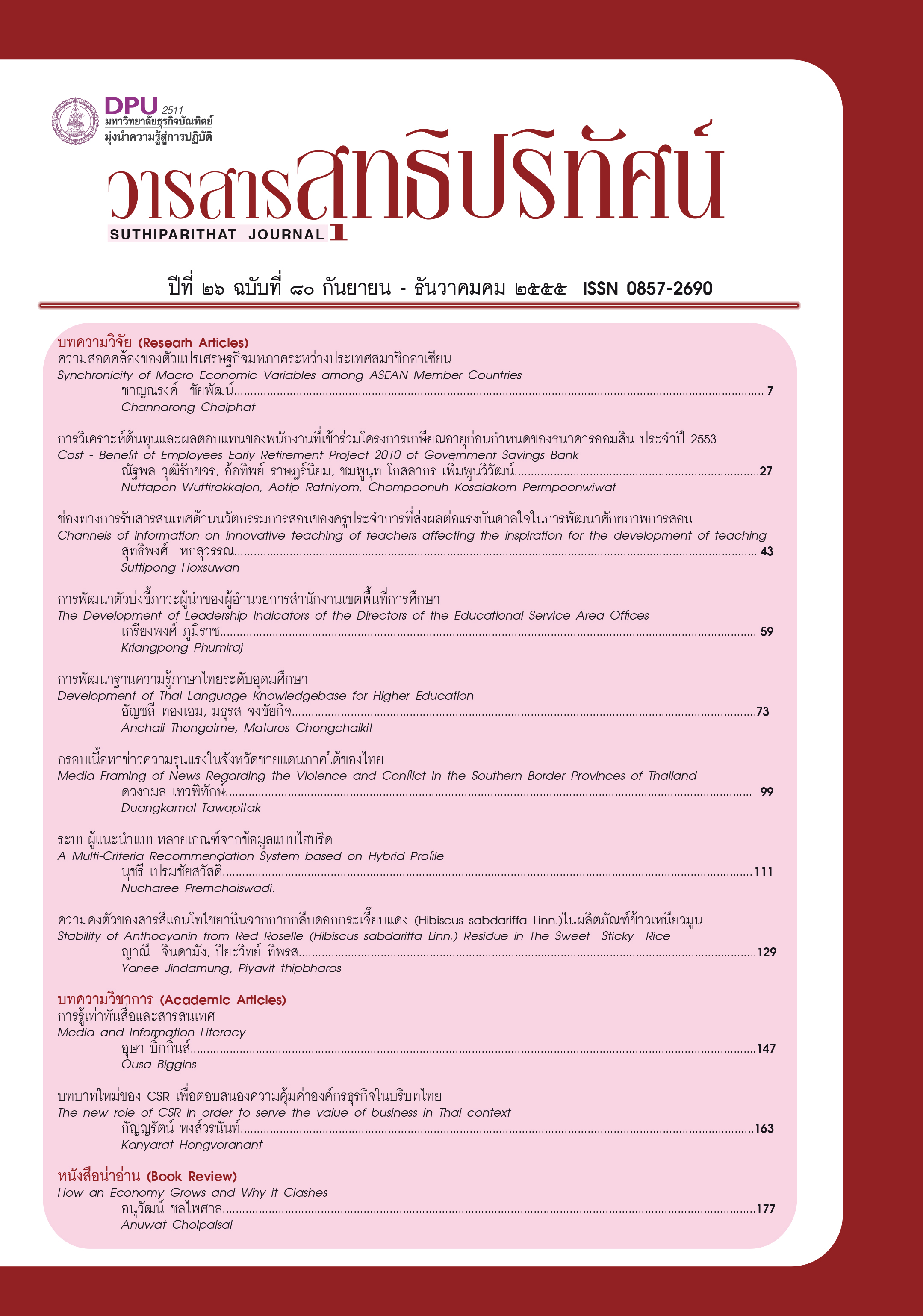STABILITY OF ANTHOCYANIN FROM RED ROSELLE (HIBISCUS SABDARIFFA LINN.) RESIDUE IN THE SWEET STICKY RICE
Keywords:
Anthocyanin Stability, Red Reselle (Hibiscus sadariffa Linn.) Residue, “KEAWNGU” Glutinous RiceAbstract
This research consisted of four experimental parts. The first part was analyses of chemical compositions of fresh red reselle (Hibiscus sadariffa Linn.) residue. It was found that the energy value (62.0 Kcal/100g), energy from fat (0.0 Kcal/100g), carbohydrates(14.1% db), protein (1.22% db), fat (0.05% db), ash (1.29% db), and moisture (83.3% db). In the second part, the effects of extraction temperature (for 60OC 80 OC or 100OC) and times (for 10, 20 , or 30 min) of the anthocyanins from fresh red reselle residue were evaluated. The experiment involved as a completely randomized design (CRD) were analysed triplicate experiments. The effects of fresh red reselle residue to distilled water (adjusted for 2.5 pH with 1% HCl) ratios was carried out at 1 : 4 w/v, respectively. The experimental results found that significantly the optimal extraction was 100 OC, 30 min which redness (a*), pH, extracted - total anthocyanin content (db) , as well as total soluble solid were 13.65, 2.29, 0.41 mg/100 mL sample, 0 OBrix, respectively. In the third part, the effects of anthocyanin solution to glutinous rice namely “KEAWNGU”(Oryza sativa Linn.) ratios at 30:70, 40 : 60, or 50 : 50 w/w on sensory evaluation with untrained 30 assessors were evaluated. To bring extracted anthocyanin solution from the optimal condition was carried out at soaked over night for 6 – 8 hrs after that to bring soaked glutinous rice were produced the sweet sicky rice with commercially standard formular. After added 3% powdered maltodextrin (DE10) as gelling agent were test by untrained 30 assessors had make hedonic scale -9- points. The experiment involved as a repeated measure design (RMD). The experimental results found that the sinificantly effects of anthocyanin solution to glutinous rice namely “KEAWNGU” ratio at 50 : 50 w/w was received score like overall acceptance, appearance, color, texture, taste or flavor were 8.1, 7.7, 8.3, 7.6, 7.9 or 7.7 , respectively. In the final part, the effects of shelf life evaluation on stability of anthocyanin in the product were studied. To bring the optimal condition of in the third part keep at 1, 2 , or 3 days when compared with control treatment (room temperature at 30±0.5OC). It was found that increasing storage days had significantly effected increasing profiles of anthocyanin contents were 0.90, 0.91, or 0.93 mg/100 g sample, respectively. In addition, the experimental results found that increasing storage days had significantly effected increasing profiles of peroxide value, and significantly effected decreasing profiles of color (L*, a*) while, no significantly effected of water activity (0.95 aw). In addition, Microbiology evaluation on the sweet stickly rice in refrigeration were studied. It was found that those obtained negative to consumer. On the other hand, sensory evaluation it was found that those obtained throughout 3 days no acceptable assessors but that significantly effected acceptable control treatment (room temperature). The experimental results found that the sinificantly effects of anthocyanin solution to glutinous rice namely “KEAWNGU” ratio at 50 : 50 w/w keep at room temperature of total anthocyanin content, energy, energy from fat , carbohydrate, moisture, protein, fat or ash were 0.21 mg/100g (wb) sample, 257.5 Kcal, 23.5 Kcal, 55.43 (wb), 38.54% (wb), 3.06% (wb), 2.60% (wb) or 0.39% (wb), respectively.
References
จรัญ เกษมรัติ. (2552). สูตรและกระบวนการผลิต ผลิตภัณฑ์ข้าวเหนียวมูน. ได้จากการสัมภาษณ์. เมื่อวันที่ 1 พฤษภาคม 2552.
ดวงกมล ลืมจันทร์. วิษฐิดา จันทราพรชัย และวิชัย หฤทัยธนาสันติ์. (2551). การสกัดแอนโทไซยา นินจากข้าวเหนียวดำ. แหล่งที่ http://www kucon.lib.ku.ac.th/cgibin/KUCON.exe?rec_id=010962&database=KUCON&search_type=link&table=mona&back_path=/KUCON/mona&lang=thai&format_name=TFMON, 6 มิถุนายน 2552
บุศรารัตน์ สายเชื้อ.(2545). แอนโทไซยานินจากกระเจี๊ยบแดง Hibiscus sabdariff L. เพื่อใช้เป็นสี ผสมอาหาร วิทยานิพนธ์ปริญญาวิทยาศาสตรมหาบัณฑิต สาขาวิชาเทคโนโลยีทางอาหาร กรุงเทพฯ : จุฬาลงกรณ์มหาวิทยาลัย.
เพชรรัตน์ เพ็งรัตน์ และอิศราภรณ์ พาณิชย์ เจริญรัตน์. (2552). ความเสถียรของแอนโทไซยานินของกระเจี๊ยบและอัญชันในผลิตภัณฑ์เครื่องดื่ม. ออนไลน์ เข้าถึงใน http://science.swu.ac.th/content/e65/e969/e1472/HomeAbstract.pdf, 6 มิถุนายน 2552
วนิดา เทวารุทธ์. (2552). การสกัดสารแอนโทไซยานินในธัญพืช. อาหาร. สถาบันค้นคว้าและพัฒนาผลิตภัณฑ์อาหาร มหาวิทยาลัยเกษตรศาสตร์, ปีที่ 39 ฉบับที่ 4 ตุลาคม – ธันวาคม 2552, หน้า 293 – 298.
เพชรรัตน์ เพ็งเจริญ และ อิศราภรณ์ พาณิชย์เจริญรัตน์. (2552). ความเสถียรของแอนโทไซยานินของกระเจี๊ยบและอัญชันในผลิตภัณฑ์เครื่องดื่ม. สืบค้นใน www.google.com, 1 หน้า.
เว็บไซต์หมอชาวบ้าน. (2552). กระเจี๊ยบมอญ. สืบค้นใน www.google.com , เมื่อวันที่ 6 มิถุนายน 2552 , 5 หน้า.
สถาบันการแพทย์แผนไทย. (2552). กระเจี๊ยบแดง. สืบค้นใน www. Google.com, สืบค้นเมื่อวันที่ 6 มิถุนายน 2552, 3 หน้า.
Gradinaru, G., Biliaderis, C. G., Kallithraka, S., Kefalas, P., and Garcia–Viguera., C. (2003). Thermal stability of Hibiscus sabdariffa L. anthocyanins in solution and in solid state : effects of copigmentation and glass transition. Journal of Food Chemistry. 83 : 423 – 436.
Prodanov, M. P., Dominguez, J. A., Blazquez, I., Salinas, M. R., and Alonso, ก. L. (2004). Someaspects of the quantitative/qualitative assessment of com mercial anthocyanin – rich extracts. Journal of Food Chemistry.90 : 585 – 596.
Veridiana, V. R., Adriana, Z., and Mercadante. (2007). Evaluation of colour and stability of anthocyanins from tropical fruits in an isotonic soft drink system. Innovative Food Science & Emerging Technologies. 8 : 347 – 352.
Wrolstad, R. E., Skrede, ก., Lea, P., & Enersen, . (1990). Influence of sugar on anthocyanin pigment stability in frozen strawberries . Journal of Food Science, 55 : 1064 – 1065, 1072.
Downloads
Published
How to Cite
Issue
Section
License
Content and information of the article published at Suthiparithat Journal are based on the sole opinions and responsibility of author(s) only. Neither the editorial board involve in......






